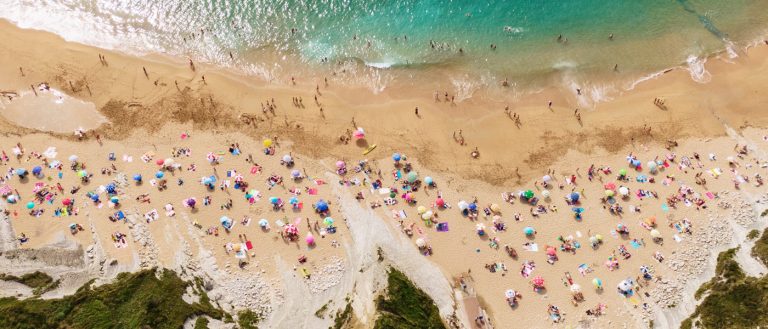
If you’ve wondered the difference one year can make, look no further than the travel industry. The summer of 2020 was marked by quarantines, stay-at-home mandates and other restrictions related to the COVID-19 pandemic, effectively putting a pause to travel plans altogether. Now, vaccines are readily available—and public confidence in traveling has increased. This summer, as ongoing vaccination efforts continue to improve health and safety, people are making plans once again to travel and vacation with friends and family.
But what does an increase in summer travel mean for the economy? We chatted with Jenny Hawkins, assistant professor of economics at Weatherhead School of Management, to look at summer travel through an economics lens.
If you’re planning to travel this summer (or anytime in the future), check out what Hawkins has to say. The economics lessons throughout are an added plus!
1. There have been unexpected changes in supply and demand.
When the pandemic hit, certain industries, especially the hospitality industry, had no choice but to make drastic decisions. For example, rental car companies sold up to one-third of their fleet as a means of survival, therefore decreasing supply. Once restrictions were lifted, demand for rental cars surged. Demand likely will remain high, and because it will take time for these rental car companies to build back their inventories, this decrease in supply and increase in demand means an increase in prices.
A recent review on Kayak.com for renting a car in Cleveland for the weekend shows a total price of $239 for 48 hours, vastly higher than the $30 per day rentals we were used to pre-pandemic. These unexpected changes in supply and demand will cause the rental car industry, and other travel-related industries, to seem a bit chaotic and disorderly, but will ultimately allow struggling companies to recoup losses from 2020 and bring back jobs lost during the pandemic.
2. Consumers are willing to pay more.
Price elasticity of demand is how sensitive consumers are to changes in the price of a good or service. After spending the majority of 2020 indoors and primarily in their homes, many consumers have become relatively less sensitive to price changes when it comes to goods and services related to travel.
This means if the price of a product or service increases, we are more willing to pay that price than we might have been pre-pandemic. Before, we might have been more willing to take a shorter trip or eat at home when we saw gasoline or restaurant prices increase. This summer, with “makeup travel” much more prevalent, many consumers are willing to pay higher restaurant and gas prices because they are eager to leave their homes and make up for the last year.
3. Priorities have changed.
The pandemic offered a reality check about our priorities in life. Because so many were unable to safely visit family and friends, and many even experienced the loss of loved ones, many are rethinking what they value most. Being forced to spend so much time indoors and with little travel made clearer our value of nature and our travel goals. Because of this, many consumer priorities have shifted, putting family, nature and bucket list travel first.
“Opportunity cost” is the value of the next best alternative option. Rational decision-makers choose the option for which their next best choice has the fewest foregone opportunities. The pandemic forced us to reevaluate our opportunity costs, and this summer, many are choosing to travel to spend time with family and friends rather than (or in addition to) travel for a typical vacation. An online survey of 1,200 Americans in April 2020 found that 61% said their first trip after restrictions are lifted would be to visit family or friends.
Others have realized that this summer is the time to check off a trip from their bucket list. A survey by travel site Tripit found that 26% of respondents said they are choosing a destination from their bucket list.
Many people also are re-examining their value of spending time in nature. A poll conducted at Penn State Harrisburg found that 80% of Pennsylvanians who visited parks and trails believe “time spent outdoors is essential to their physical and mental health during the pandemic.” Another survey found that 58% of respondents “didn’t appreciate nature as much as they should have before the COVID-19 pandemic.”
4. Shortages across the industry abound.
Simply put, shortages occur when quantity demanded is greater than quantity supplied. Dining out while on vacation is a frequent “to-do” for travelers. How will that change this season? The restaurant industry is facing shortages across the board, from labor shortages to food shortages.
Don’t be surprised if you aren’t seated right away because of a lack of staff. Over recent months since pandemic restrictions have relaxed, the quantity demanded for restaurant meals has been greater than the quantity that can be supplied.
5. Prices have increased.
Prices in many industries, especially those related to travel, have increased due to increases in demand and disruptions in supply chains. For example, gas has increased 45% since July 2020 and 19% since July 2019—still higher than pre-pandemic prices. Some price increases will be short-term and revert to pre-pandemic levels once demand decreases and/or supply increases. Hotel prices took a sharp decline early in the pandemic but now are reverting, and due to so much demand, might even be a bit higher than pre-pandemic.
Prices of some goods and services might remain higher for the long term, contributing to overall inflation. For example, restaurants are seeing labor shortages and rising wages. Because of the nature of pricing restaurant meals, these higher restaurant prices are more likely to stick post-pandemic.


